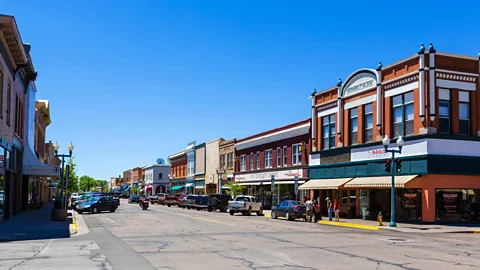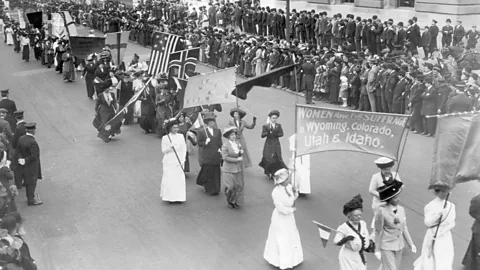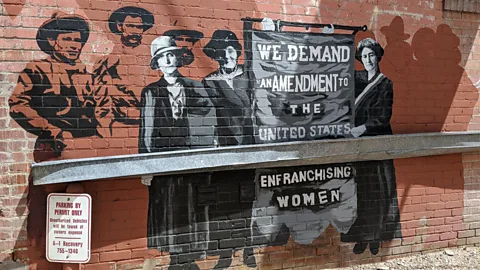Louisa Swain: The travelling grandma who forever changed the US
 Visit Laramie
Visit LaramieThis sparsely populated Wild West frontier effectively kick-started women's suffrage by granting women the right to vote before they could elsewhere in the US.
On 6 September 1870, Louisa Ann Swain, a grandmother in Laramie, Wyoming, put a clean apron over her house dress, donned a knitted bonnet and got ready for her early morning walk. Swain was 70 years old, still agile and strong, and she had recently moved to Laramie with her husband to live near their son. She took her little bucket and headed to the downtown bakery to buy yeast so she could bake bread. It was a walk she had taken many times before, but on this day she was going to take a small detour with big implications.
On her way, she stopped to cast her vote.
This incident took place 50 years before the United States Congress passed the 19th Amendment granting women the right to vote. Yet, Swain was able to legally cast her ballot because in December 1869, the legislators of the Wyoming territory passed a law giving women unrestricted voting rights. At the time, no other state or US territory allowed women this right, and seemingly overnight, Wyoming – a Western frontier territory of a few thousand people – catapulted to the forefront of the Women's Suffrage Movement.
Wyoming was holding its first election since the Suffrage Act was passed the morning Swain went to the poll. An early riser, Swain happened to be in the right place at the right time to become the state's first female voter.
 Alpha Stock/Alamy
Alpha Stock/Alamy"Louisa was an inspiration to other women – and she still is our inspiration that all things are possible for women," said Mary Mountain, executive director for the Louisa Swain Foundation in Laramie, which is dedicated to preserving and celebrating Swain's memory in the trailblazing territory. "That's why we're known as 'The Equality State'… There's really quite a beautiful line in our constitution that gives men and women the exact same rights."
These rights went beyond just voting. Wyoming's 1869 Suffrage Act also gave women the right to own and inherit property, and even to hold public office. It also granted them guardianship of their minor children; prior to that, if a woman's husband died, her children would belong to their father's family.
"With that law, the women were able to manage their own children, manage their own money and hold a job without having to give their money to a man," Mountain said. According to Mountain, the very act of Swain voting changed how Wyoming's society viewed women and inspired other territories and states to follow.
Born into a Quaker family in Norfolk, Virginia, Swain lost her father when she was seven years old. He was a sea captain who didn't return from a voyage one day, so her mother moved to Charleston, South Carolina, to be closer to her family. She too died soon after, so Swain grew up in foster homes, learning needlework, spinning and weaving. Around 1821, she married Steven Swain. The couple lived in Baltimore, Maryland, had four children and began moving west – first to Ohio and then to Indiana. When one of their sons moved to Wyoming, Swain and her husband followed.
To celebrate Swain's historic act, the Louisa Swain Foundation operates the Wyoming Women's History House in Laramie. Swain's statue, located at the entrance, depicts her clutching her yeast bucket the day she cast her ballot. More photographs and artefacts from her life await inside.
 Hi-Story/Alamy
Hi-Story/Alamy"She was an ordinary woman doing an extraordinary thing for her time," said Mountain. "So, we try to tell the history of who she was and what she did, and we show pictures and illustrations about the 1869 Suffrage Act." A short walk away from the Wyoming Women's History House, the Laramie Plains Museum (located in a restored historic mansion) also dedicates a room to the history of the Wyoming Suffrage Act.
Interestingly, while Swain is often touted as the US' first female voter, she wasn't actually the first.
In 1776, New Jersey passed a law allowing women who owned property to vote, but rescinded that law in 1807. According to historian Kylie McCormick who teaches at Casper College in Wyoming, Utah followed Wyoming's example and passed its own Suffrage Act two months after Wyoming in February 1870. However, it held its elections before Wyoming did, therefore enabling women in Utah to cast their votes first. Yet, Utah's Suffrage Act was different: while it gave women the right to vote, it didn't give them right to hold office, noted Kim Viner, a docent at the Laramie Plains Museum.
As Viner noted, "What made Louisa Swain historic is that she was the first woman ever to vote with full equal political rights with a man."
There were a few reasons why the Wild West frontier of Wyoming opted for such an egalitarian law. One was that the Wyoming territory had very few women – partly because of its extreme remoteness and partly due to its harsh climate. Men hoped that by allowing women to buy and own land, run their own businesses, hold office and vote, they would entice more of them to come. Wyoming was also seeking statehood, for which it needed to a minimum of 66,000 residents, which was another impetus to boost its population, according to Mountain. "The Wyoming territorial legislators thought, 'If we give women the same rights as men, they might choose us over other territories'," she said.
 Paul Thompson/Getty Images
Paul Thompson/Getty ImagesYet, the primary reason, McCormick said, was less progressive. When Congress passed the 15th Amendment granting African American men the right to vote in February 1869, many white men did not take it well. Wyoming legislator William Bright, a Southerner originally from Virginia, was one of them. At some point, he met Esther Hobart Morris, a suffragist who worked closely with famed social reformers Susan B Anthony and Elizabeth Cady Stanton, who educated him about women's rights. That influenced Bright's decision during the legislative debates, where he had been quoted as saying that if African American men could vote, so could his wife. Therefore, to a large extent, the women's suffrage movement in Wyoming was a reaction to Black enfranchisement, said McCormick.
Regardless of the reasons, Wyoming's 1869 Suffrage Act gave rise to a new generation of influential women. After Utah, the territories of Montana, Washington and Colorado also gave women the right to vote. These legislative changes had a profound effect on the US' Western culture, and not only changed how women viewed themselves, but also how men viewed women. Empowered by the new laws, women held office, owned businesses and served as jurors. In 1870 alone, Morris became the first female Justice of the Peace in South Pass City, Wyoming; and Martha Symon Boies became the first woman bailiff in Laramie. Six women were also summoned to sit alongside men as the first female jurors that same year. In the years that followed, Western women became town mayors and even governors, breaking the glass ceiling in ways unheard of at the time.
These trailblazing women's legacies are preserved in the Females' First exhibit in the Wyoming Women's History House that documents their achievements with posters and photographs. One of the museum's rooms screens a PBS documentary movie, The State of Equality: Wyoming Women Get the Vote, which tells stories of women who left their mark on American history.
In the years that followed Wyoming's 1869 Suffrage Act, many Western men began to view women as equal partners. When Annie Oakley, a legendary markswoman who never missed a shot, joined Buffalo Bill's Wild West Show in 1888 and went on tour in Europe, she was paid as much as the male performers. The Buffalo Bill Center of the West in Cody, Wyoming, recounts Oakley's story, while Buffalo Bill is quoted as saying: "If a woman can do the same work that a man can do, and do it just as well, she should have the same pay."
 Visit Laramie
Visit LaramieWhen the US Congress was hesitant to admit Wyoming as a state in 1890 because it allowed women to vote, the state's legislators refused to change the law. According to Viner, they sent a telegram – which, sadly didn't survive – expressing the idea that: "We will remain out of the Union for 100 years unless we can come in with women," Viner said. Congress acquiesced, and Wyoming became a state.
Although Swain made history that day, she didn't stay in Wyoming for long. Whether it was the harsh winters or other reasons, she moved back east with her husband shortly after, settling in Maryland near her daughter. She died 10 years later and is buried in Friends Burial Ground in Baltimore. But in the heart and minds of Wyoming women, she lives on. Every 6 September, staff from the Louisa Swain Foundation walk in her footsteps – and even in "her clothes", too, Mountain said.
"Our local ladies dress up like Louisa and they reenact her walk with her little yeast bucket. It is an important moment to remember for all of us."
Rediscovering America is a BBC Travel series that tells the inspiring stories of forgotten, overlooked or misunderstood aspects of the US, flipping the script on familiar history, cultures and communities.
---
If you liked this story, sign up for the weekly bbc.com features newsletter called "The Essential List". A handpicked selection of stories from BBC Future, Culture, Worklife and Travel, delivered to your inbox every Friday.
